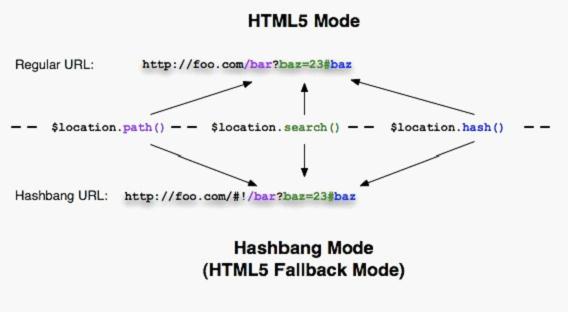AngularJS $location学习笔记
一、$lacation能做什么?
$location服务分析浏览器地址栏中的URL(基于window.location),让我们可以在应用中较为方便地使用URL里面的东东。在地址栏中更改URL,会响应到$location服务中,而在$location中修改URL,也会响应到地址栏中。
1. $locationProvider:
1. 暴露当前浏览器地址栏的URL,所以我们可以注意和观察URL
2. 改变URL,当用户做以下操作时,与浏览器一起同步URL:
改变地址栏
单击后退或者前进按钮(或者点击一个历史链接)。
单击一个链接
将URL对象描绘为一系列的方法(protocol,host,path,search,hash)。
1. 比较$location和window.location
1) 目的:window.location和$location服务,都允许对当前浏览器的location进行读写访问。
2) API:window.location暴露一个未经加工的对象,附带一些可以直接修改的属性;而$location服务则是暴露一些jQuery风格的getter/setter方法。
3) 与angular应用声明周期的整合:$location知道关于所有内部声明周期的阶段,与$watch等整合;而window.location则不行。
4) 与HTML5 API无缝结合:是(with a fallback for legacy browsers,对于低版本的浏览器有兼容手段?);而window.location则没有。
5) 知道应用加载的文档根目录(docroot)或者上下文(context):window.location不行,wnidow.location.path会返回”/docroot/子路径”;而$location.path()返回真实的docroot。
2. 什么时候应该用 $location?
在应用中,任何需要对当前URL的改变作出响应,或者想去改变当前浏览器的URL的时候。
3. 什么时候不应该用?
当浏览器URL改变的时候,不会导致页面重新加载(page reload)。如果需要做这件事情(更改地址,实现pagereload),请使用较低级别的API,$window.location.href。
二、General overview of the API(API的总体概述)
$location 服务可以根据它初始化时的配置而有不同的表现。默认配置是适合大多数应用的,其他配置定制,可以开启一些新特性。
当$location服务初始化完毕,我们可以以jQuery风格的getter、setter方法来使用它,允许我们获得或者改变当前浏览器的URl。
配置$location服务
想配置$location服务,需要获得$locationProvider,并设置以下参数:
html5Mode(mode):{boolean},true - see HTML5 mode;false - see Hashbang mode,默认: false。
hashPrefix(prefix):{string},hashbang使用的前缀(html5Mode为false时,使用hashbang mode,以适应不支持HTML5 mode的浏览器),默认:’!’Getter and setter method
$location 服务为只读的URL部分(absUrl,protocol,host,port)提供getter方法,也提供url,path,search,hash的getter、setter方法。
// get the current path
$location.path();
// change the path
$location.path('/newValue') 所有setter方法都返回同一个$location对象,以实现链式语法。例如,在一句里面修改多个属性,链式setter方法类似:
`
$location.path(‘/newValue’).search({key:value});
有一个特别的replace方法,可以用作告诉$location服务,在下一次与浏览器同步时,使用某个路径代替最新的历史记录,而不是创建一个新的历史记录。当我们想实现重定向(redirection)而又不想使后退按钮(后退按钮回重新触发重定向)失效时,replace方法就很有用了。想改变当前URL而不创建新的历史记录的话,我们可以这样做:
$location.path(‘/someNewPath’).replace();
注意,setter方法不会马上更新window.location。相反,$location服务会知道scope生命周期以及合并多个$location变化为一个,并在scope的$digest阶段一并提交到window.location对象中。正因为$location多个状态的变化会合并为一个变化,到浏览器中,只调用一次replace()方法,让整个commit只有一个replace(),这样不会使浏览器创建额外的历史记录。一旦浏览器更新了,$location服务会通过replace()方法重置标志位,将来的变化将会创建一个新的历史记录,除非replace()被再次调用。
Setter and character encoding
我们可以传入特殊字符到$location服务中,服务会按照RFC3986标准,自动对它们进行编码。当我们访问这些方法时:
所有传入$location的setter方法的值,path()、search()、hash(),都会被编码。
getter方法(没参数)返回的值都是经过解码的,如path(),search(),hash()。
当我们调用absUrl()方法时,返回的值是包含已编码部分的完整url。
当我们调用url()方法时,返回的是包含path、search和hash部分的已经编码的url,如/path?search=1&b=c#hash。
三、Hashbang and HTML5 Modes
$location服务有两个配置模式,可以控制浏览器地址栏的URL格式:Hashbang mode(默认)与基于使用HTML5 History API的HTML5 mode。在两种模式下,应用都使用相同的API,$location服务会与正确的URL片段、浏览器API一起协作,帮助我们进行浏览器URL变更以及历史管理。

- Hashbang mode (default mode)
在这个模式中,$location在所有浏览器中都使用Hashbang URL。查看下面的代码片段,可以了解更多:
it('should show example', inject(
function($locationProvider) {
$locationProvider.html5mode = false;
$locationProvider.hashPrefix = '!';
},
function($location) {
// open http://host.com/base/index.html#!/a
$location.absUrl() == 'http://host.com/base/index.html#!/a';
$location.path() == '/a';
$location.path('/foo');
$location.absUrl() == 'http://host.com/base/index.html#!/foo';
$location.search() == {};//search没东东的时候,返回空对象
$location.search({a: 'b', c: true});
$location.absUrl() == 'http://host.com/base/index.html#!/foo?a=b&c';
$location.path('/new').search('x=y');//可以用字符串的方式更改search,每次设置search,都会覆盖之前的search
$location.absUrl() == 'http://host.com/base/index.html#!/new?x=y';
}
)); Crawling your app(让google能够对我们的应用进行索引)
如果我们想让我们的Ajax应用能够被索引,我们需要在head中增加一个特殊的meta标签:
这样做,将让爬虫机器人使用escaped_fragment参数请求当前的链接,让我们的服务器认识爬虫机器人,并提供对应的HTML快照。想了解更多关于这个技术的信息,可以查看https://developers.google.com/webmasters/ajax-crawling/docs/specification?hl=zh-CN
四、HTML5 mode
在HTML5模式中,$location服务的getter、setter通过HTML5的History API与浏览器URL进行交互,允许使用正规的path、search模块,代替hashbang的模式。如果部分浏览器不支持HTML5 History API,$location服务会自动退回到使用hashbang URL的模式。为了让我们能够从不清楚显示我们的应用的浏览器是否支持history API的担心中解脱出来,使用$location服务是一个正确的、最佳的选择。
在旧版浏览器中打开一个正规的URL会转换为hashbangURL。
在现代浏览器中打开一个hashbangURL,会重写为一个正规的URL。
1. 向前兼容旧版浏览器
对于支持HTML5 history API 的浏览器,$location回使用它们去写path和search。如果浏览器不支持history API,$location会转为提供Hashbang URL。这是$location服务自动转换的。
- HTML link rewriting
当我们使用historyAPImode的时候,我们对于不同的浏览器,需要不同的链接,但我们只需要提供正规的URL即可,例如link
当用户单击这个超链接时:
在旧的浏览器中,URL会改为/index.html#!/some?foo=bar
在现代浏览器中,URL会改为/some?foo=bar在下面的情况中,链接不会被重写,而是会使页面加载到对应Url中:
包含target的超链接:link
到不同domain的绝对链接:link
设置了base路径后,通过” /”开头的链接到不同base路径的超链接:link - server side
使用这个方式,在服务端请求URL重定向,通常,我们需要重定向我们所有的链接到我们的应用中。(例如index.html)。 - Relative links
确保检查所有相对链接、图片、脚本等。我们必须在中指定base url(),并在所有地方使用绝对url(以/开头)。因为相对URL会根据document的初始路径(通常与应用的root有所不同),转化为绝对url。(relative urls will be resolved to absolute urls using the initial absolute url of the document, which is often different from the root of the application)。我们十分鼓励在document root中运行允许使用History API的angular应用,因为这很好地照顾到相对链接的问题。 - 例子
下面的例子中可以看到两个 $location实例,两个都是html5 mode,但在不同的浏览器上,所以我们可以看到两者之间的不同点。这些$location服务与两个假的“浏览器”连接。每一个input代表浏览器的地址栏。
注意,当我们输入hashbang地址到第一个“浏览器”(或者第二个?),它不会重写或重定向另外的Url,这个转换过程只会发生在page reload的时候。
<!DOCTYPE html>
<html ng-app>
<head>
<base href=""/>
<meta http-equiv="Content-Type" content="text/html; charset=utf-8"/>
<title>fake-browser</title>
<meta content="IE=edge,chrome=1" http-equiv="X-UA-Compatible">
<style type="text/css">
.ng-cloak {
display: none;
}
</style>
</head>
<body>
<div ng-non-bindable class="html5-hashbang-example">
<div id="html5-mode" ng-controller="Html5Cntl">
<h4>Browser with History API</h4>
<div ng-address-bar browser="html5"></div><br><br>
$location.protocol() = {{$location.protocol()}}<br>
$location.host() = {{$location.host()}}<br>
$location.port() = {{$location.port()}}<br>
$location.path() = {{$location.path()}}<br>
$location.search() = {{$location.search()}}<br>
$location.hash() = {{$location.hash()}}<br>
<a href="http://www.host.com/base/first?a=b">/base/first?a=b</a> |
<a href="http://www.host.com/base/sec/ond?flag#hash">sec/ond?flag#hash</a> |
<a href="/other-base/another?search">external</a>
</div>
<div id="hashbang-mode" ng-controller="HashbangCntl">
<h4>Browser without History API</h4>
<div ng-address-bar browser="hashbang"></div><br><br>
$location.protocol() = {{$location.protocol()}}<br>
$location.host() = {{$location.host()}}<br>
$location.port() = {{$location.port()}}<br>
$location.path() = {{$location.path()}}<br>
$location.search() = {{$location.search()}}<br>
$location.hash() = {{$location.hash()}}<br>
<a href="http://www.host.com/base/first?a=b">/base/first?a=b</a> |
<a href="http://www.host.com/base/sec/ond?flag#hash">sec/ond?flag#hash</a> |
<a href="/other-base/another?search">external</a>
</div>
</div>
<script src="../angular.js" type="text/javascript"></script>
<script type="text/javascript">
function FakeBrowser(initUrl, baseHref) {
this.onUrlChange = function(fn) {
this.urlChange = fn;
};
this.url = function() {
return initUrl;
};
this.defer = function(fn, delay) {
setTimeout(function() { fn(); }, delay || 0);
};
this.baseHref = function() {
return baseHref;
};
this.notifyWhenOutstandingRequests = angular.noop;
}
var browsers = {
html5: new FakeBrowser('http://www.host.com/base/path?a=b#h', '/base/index.html'),
hashbang: new FakeBrowser('http://www.host.com/base/index.html#!/path?a=b#h', '/base/index.html')
};
function Html5Cntl($scope, $location) {
$scope.$location = $location;
}
function HashbangCntl($scope, $location) {
$scope.$location = $location;
}
function initEnv(name) {
var root = angular.element(document.getElementById(name + '-mode'));
angular.bootstrap(root, [
function ($compileProvider, $locationProvider, $provide) {
debugger;
$locationProvider.html5Mode(true).hashPrefix('!');
$provide.value('$browser', browsers[name]);
$provide.value('$document', root);
$provide.value('$sniffer', {history:name == 'html5'});
$compileProvider.directive('ngAddressBar', function () {
return function (scope, elm, attrs) {
var browser = browsers[attrs.browser],
input = angular.element('<input type="text" style="width:400px;">').val(browser.url()),
delay;
input.bind('keypress keyup keydown', function () {
if (!delay) {
delay = setTimeout(fireUrlChange, 250);
}
});
browser.url = function (url) {
return input.val(url);
};
elm.append('Address: ').append(input);
function fireUrlChange() {
delay = null;
browser.urlChange(input.val());
}
};
});
}
]);
root.bind('click', function (e) {
e.stopPropagation();
});
}
initEnv('html5');
initEnv('hashbang');
</script>
</body>
</html>五、附加说明
Page reload navigation
$location服务仅仅允许我们改变URl;它不允许我们重新加载页面(reload the page)。当我们需要改变URL且reload page或者跳转到其他页面时,我们需要使用低级点得API,$window.location.href。Using $location outside of the scope life-cycle
$location知道angular的scope life-cycle。当浏览器的URL发生改变时,它会更新$location,并且调用$apply,所以所有$watcher和$observer都会得到通知。当我们再$digest阶段中修改$location,不会出现任何问题;$location会将这次修改传播到浏览器中,并且通知所有$watcher、$observer。当我们需要在angular外面改变$location时(例如在DOM事件中或者在测试中),我们必须调用$apply,以传播这个变化。$location.path() and ! or / prefixes
path可以直接使用”/”开始;$location.path()setter会在value没有以”/”开头时自动补上。
注意”!”前缀,在Hashbang mode中,不属于$location.path()的一部分。它仅仅是hashPrefix。
六、Testing with the $location service
在测试中使用的$location服务的处于scope的life-cycle之外。这意味着我们需要主动负责调用scope.apply()。
describe('serviceUnderTest', function() {
beforeEach(module(function($provide) {
$provide.factory('serviceUnderTest', function($location){
// whatever it does...
});
});
it('should...', inject(function($location, $rootScope, serviceUnderTest) {
$location.path('/new/path');
$rootScope.$apply();
// test whatever the service should do...
}));
});七、Migrating from earlier AngularJS releases
在早期的angular中,$location使用hashPath或者hashSearch去处理path和search方法。在这个release中,当有需要的时候,$location服务处理path和search方法,然后使用那些获得得信息去构成hashbang URL(例如http://server.com/#!/path?search=a)。
八、Two-way binding to $location
angular compiler当前不支持方法的双向绑定(https://github.com/angular/angular.js/issues/404)。如果我们希望对 location对象实现双向绑定(在input中使用ngModeldirective),我们需要指定一个额外的model属性(例如:locationPath),并加入两个 watch,监听两个方向上的$location更新,例如:
<input type="text" ng-model="locationPath" />$scope.$watch('locationPath', function(path) {
$location.path(path);
);
$scope.$watch('$location.path()', function(path) {
scope.locationPath = path;
});





















 768
768











 被折叠的 条评论
为什么被折叠?
被折叠的 条评论
为什么被折叠?








